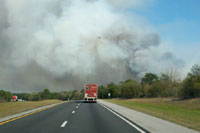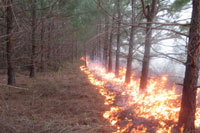Browse our Growing Library of Success Stories
By:
USDA Forest Service Over four long days in late March 2011, the most severe wildfire outbreak in a decade occurred at Eglin Air Force Base, located near Destin, Florida (Fig. 1). A persistent drought, 20 mph winds and low humidity, combined with 12-15 arson fires on the property, resulted in 6,000 acres burned in a matter of days. Due to Eglin’s aggressive prescribed fire program, the March 2011 wildfire severity and acres burned were significantly reduced. Without this regular fuel reduction, anywhere from 10-12,000 acres could have burned just on the Eglin side, with untold acres burned and property damaged north of Interstate 10.
Over four long days in late March 2011, the most severe wildfire outbreak in a decade occurred at Eglin Air Force Base, located near Destin, Florida (Fig. 1). A persistent drought, 20 mph winds and low humidity, combined with 12-15 arson fires on the property, resulted in 6,000 acres burned in a matter of days. Due to Eglin’s aggressive prescribed fire program, the March 2011 wildfire severity and acres burned were significantly reduced. Without this regular fuel reduction, anywhere from 10-12,000 acres could have burned just on the Eglin side, with untold acres burned and property damaged north of Interstate 10.
By:
US Forest Service On July 14, 2015, a lightning strike ignited a wildfire on Bald Knob in the Grandfather Ranger District (GRD) of the Pisgah National Forest. Only 30 miles outside of Asheville, North Carolina and on rugged terrain difficult to access, the wildfire may have posed greater threat had it not been adjacent to areas containing recent fuel treatments (prescribed fire) and wildfires. These treatments, as part of the Collaborative Forest Landscape Restoration Program (CFLRP), reduced fire fuel loads in the forest and enabled the Bald Knob fire to safely burn while protecting firefighters, local residents, structures, power line corridors, communication towers, and Forest Service property and surrounding land. Fuel treatments positively influenced the fire’s spread and allowed firefighting efforts to truly focus on protection of private properties. The inaccessible terrain as well as the confine and contain strategy allowed ample time to keep the effected community well informed of current fire behavior, smoke impacts and management plans for the fire.
On July 14, 2015, a lightning strike ignited a wildfire on Bald Knob in the Grandfather Ranger District (GRD) of the Pisgah National Forest. Only 30 miles outside of Asheville, North Carolina and on rugged terrain difficult to access, the wildfire may have posed greater threat had it not been adjacent to areas containing recent fuel treatments (prescribed fire) and wildfires. These treatments, as part of the Collaborative Forest Landscape Restoration Program (CFLRP), reduced fire fuel loads in the forest and enabled the Bald Knob fire to safely burn while protecting firefighters, local residents, structures, power line corridors, communication towers, and Forest Service property and surrounding land. Fuel treatments positively influenced the fire’s spread and allowed firefighting efforts to truly focus on protection of private properties. The inaccessible terrain as well as the confine and contain strategy allowed ample time to keep the effected community well informed of current fire behavior, smoke impacts and management plans for the fire.
By:
U.S. Fish and Wildlife Service Enon-Sehoy Plantation, located in the Alabama Upper Coastal Plains, is a recreational, quail hunting property renowned for its open-story pine trees and diverse wildlife. The 27,500 acre, privately-owned property contains widely spaced longleaf, shortleaf, loblolly, and slash pine forests (basal area of 15-60 square feet per acre) with diverse understory grasses and forbs, such as bluestem, switchgrass, and the federally endangered American chaffseed. The forests and understory vegetation support abundant wildlife, including deer, turkey, and quail, as well as the threatened Bachman’s sparrow and the federally endangered red-cockaded woodpecker. Within four years, the property’s red-cockaded woodpecker population grew from just 3 clusters to 29 potential breeding groups.
Enon-Sehoy Plantation, located in the Alabama Upper Coastal Plains, is a recreational, quail hunting property renowned for its open-story pine trees and diverse wildlife. The 27,500 acre, privately-owned property contains widely spaced longleaf, shortleaf, loblolly, and slash pine forests (basal area of 15-60 square feet per acre) with diverse understory grasses and forbs, such as bluestem, switchgrass, and the federally endangered American chaffseed. The forests and understory vegetation support abundant wildlife, including deer, turkey, and quail, as well as the threatened Bachman’s sparrow and the federally endangered red-cockaded woodpecker. Within four years, the property’s red-cockaded woodpecker population grew from just 3 clusters to 29 potential breeding groups.